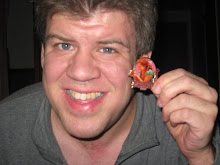

Unless I see a new movie in the waning hours of 2010, my theatrical filmgoing ends with The King's Speech - and what a wonderful finale that is.
I was actually rather surprised that I loved the film. Typically, I'm not into what a friend of mine once called "tea party movies" - otherwise known as period pieces. Years ago, while every critic was raving about Howards End, I could give it only a respectful shrug. Well acted, certainly - but stories of Brits struggling with their social status simply didn't ring many bells for me.
So what made The King's Speech different? Simply put, the story can't fail to be inspiring. Colin Firth plays Prince Albert, who has trouble cutting a regal figure, especially with the rise of the radio. In the old days, it was enough for a king simply not to fall off his horse. But Albert has a more difficult time than most because he has a debilitating stammer, which makes speaking in public an embarrassment.
Albert goes to see several speech therapists, all of whom fail miserably. Then, his wife, Elizabeth (Helena Bonham Carter) hears about a specialist, Lionel Logue (Geoffrey Rush) with unorthodox methods. Albert reluctantly agrees to see him, scoffing when Lionel insists that his problems are not physical but psychological. The stakes get higher when it becomes clear that Albert's brother Edward (Guy Pearce) has little interest in being king.
My co-worker Hannah Poturalski enjoyed the film more than she expected as well. She writes:
I was pleasantly surprised while watching The King’s Speech from Director Tom Hooper (“EastEnders”) and writer David Seidler (The King and I). English films while usually always good in the end, aren’t top picks for me. I’d much rather watch American actors and directors. But I wholeheartedly enjoyed seeing into the life of English royalty and the hardships that connect all people by transcending culture and classes.
Firth and Rush both shine in their roles. The film surprised me by being so funny, and that's due primarily to Rush's work. His character has no qualms about breaking rules, cracking jokes and making people mad to get results. Most importantly, he sees a regal bearing in Albert that most people don't - and the crucial part is getting Albert not only to speak it but believe it.
With Firth's performance, that wasn't hard for me. Albert has tremendous issues, to be sure, but Firth must also convey a strength and resolve in spite of them, and Firth does so with the kind of sure-handedness that doesn't seem so much like acting. He simply is the king.
Hannah agrees, writing:
Firth’s character was able to go from stubborn and shy to opening up and letting himself have a true friendship with his unconventional but hilarious speech therapist Lionel (Geoffrey Rush). Rush almost stole the show for me. He played such a thoughtful character that just happened to use tough love as his approach for getting King George over the big hump that was his low self-esteem.
Truly, every performance, large and small, is outstanding. Helena Bonham Carter brings a pleasing light touch to her role as the long-suffering but steadfast wife, and even though his role is minor, Timothy Spall is a standout, absolutely capturing Winston Churchill. I'd love to see a biopic about Churchill with Spall in the lead.
Writer David Seidler and director Tom Hooper bring it all together with excellent craftsmanship. The movie could have come across like a filmed play, but Hooper opens up the action well, and Seidler strikes just the right balance in the story that keeps it from being too stuffy or maudlin.
It's giving nothing away to say the king succeeds in the end, but as Roger Ebert so rightly says, it's not what a movie is about, it's HOW it's about it. The King's Speech doesn't just talk. It sings.
UPDATE
I took a second look at the film, and if anything came away even more impressed. This time, I was able to pay more attention to the craft of the film, and I am no longer so surprised at all the technical nominations it has earned. They are all deserved, most especially for Danny Cohen's photography. Cohen cleverly frames the shots to drive home the point of how the king feels dwarfed by his duties, with wide-angle lenses enhancing the effect.
The King's Speech is so good, it compels me to emphasize that in NO way is would this film be an unworthy Oscar winner. As Bertie himself might put it, those buggers who decry the film's status as the front runner can cut the shit. They really need to fucking get over themselves.
Read Hannah's full take here:
GRADE: A+




























